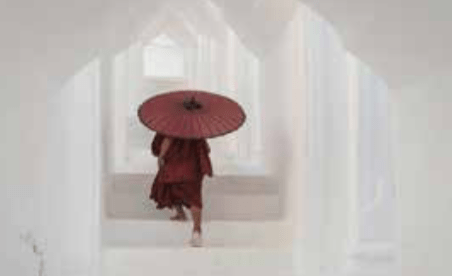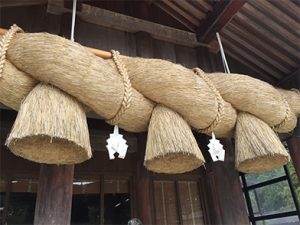
What is a Shimenawa?
The universe might in fact be bound together by an network of connections like this that tie us to persons, places, and even to the realm of the spirit. We can learn to sense these threads, and follow them to live life with more connection and more integrity.

In the intervening years, I have returned to this picture again and again, for inspiration, for guidance, and for understanding. And my thoughts about this picture have evolved. To be sure, it does provide a clear image of bonded love that is heart-warming. But I have come to believe that this picture also provides important clues about the nature and structure of the universe in which we find ourselves – clues that can help us re-think our relationship to the cosmos, integrate our sense of a spiritual reality with the job of living an everyday life, and ultimately help us become better human beings. All that from a single picture? Let me try to explain.

Are the threads represented by shimenawa simply metaphorical and symbolic? Or can they possibly be real in some fundamental way? If you have ever been deeply in love, you might easily opt for believing that threads are real. Down through history, lovers have consistently reported an uncanny ability to connect with each other, to be present to each other, across wide gulfs of time and space. Across thousands of miles. Across not just years but decades. Perhaps even across the boundary between life and death.
In other words, people who are deeply in love report being able to actually feel the thread that binds them to their loved one. And to feel even the heartbeat of their lover by means of the thread. To be sure, love provides a strong bond between two people – perhaps the strongest that is available to us on this earth.
There is also emerging scientific support for these connections. The notion of “quantum entanglement”, where particles show evidence of sharing a common state, even at great distances, was first envisioned by Einstein in 1935, and validated with experimental evidence beginning in the late ‘60’s, in spite of the fact that it seems to violate all of our common sense intuitions about the physical world.
If there is a reality to such connections, then, it would not be surprising that lovers would feel them most acutely. But if such threads are real for lovers, it raises a host of new questions that demand answers – do threads exist that connect us to others who are not our lovers? To our family? To our friends? To our enemies even? To times and places? To Heaven? Can we learn to feel these threads? Can we learn to “follow” them, whatever that might mean? And what can following these threads do for us?
My own personal experience has lead me to suspect that the universe might in fact be bound together by an network of connections like this that tie us to persons, places, and even to the realm of the spirit. That we can, if we choose, learn to sense these threads. That the threads themselves embody suggestions as to how we might want to live our life. And that following these threads by obeying the suggestions they contain can help us to act with more integrity, to integrate our spiritual life with our everyday life, and ultimately to put us in more direct contact with the realm of the spirit.
I’m not trying to claim that these ideas represent some “ultimate reality” – what is important is to figure out how we can effectively navigate this reality in which we find ourselves, regardless of its ultimate nature. From this perspective, threads are a “model” for how we should think and act in concert with the worlds of flesh and spirit that it is our nature as human beings to straddle. A model that helps us build the connections we desire. A model that facilitates our personal and spiritual growth.
Similar ideas can be found in nearly all of the great world religions. Terms like “grace”, or “chi”, or “prana”, refer to concepts closely related to shimenawa. This is not some new religious concept, but rather, hopefully, a concrete and useful way to think about the religious intuitions you have already gathered from your own experience and traditions.
You can only judge this “model” in light of your own experience. If you learn how to find threads, feel their energy, follow them, and find that you are happy you have done so, then the model works for you. If, after some effort, you find that the model just doesn’t work, drop it and move on to something that does. Please don’t take my word for anything. All I can do is share with you my own experience in hopes that you it will help you in becoming the person you were meant to become. And in that endeavor, I wish you every success.
